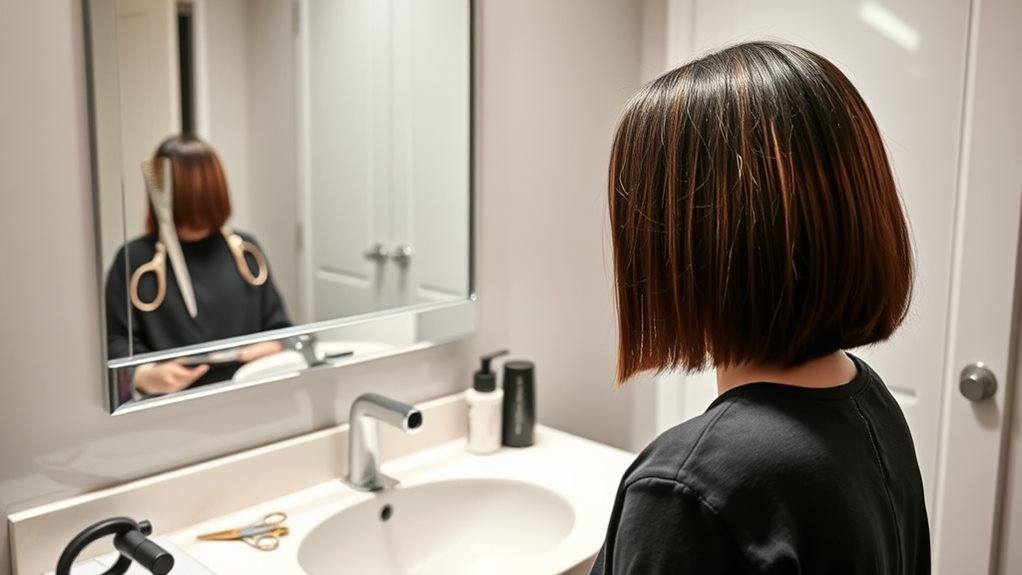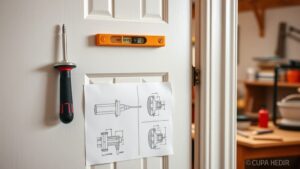Cutting your own bob haircut at home is both cost-effective and empowering. First, invest in quality hair scissors and gather a comb, clips, and a spray bottle. Make sure your hair is clean and dry, then section it off with clips. Start by creating a middle part, using the bottom layer as a guide. Use straight or point cutting techniques for the desired style, regularly checking for symmetry. You can save hundreds in salon costs annually while maintaining your new look with regular trims at home. Stay tuned for tips and techniques to perfect your DIY haircut!
Essential Tools for Home Haircuts
When you decide to cut your own hair, having the right tools is essential for achieving a polished look. Investing in quality haircutting tools like hair scissors, which are specifically designed for clean cuts, is your first step.
Tools like FreeAgent can help freelancers manage their expenses and save money for these vital items. Avoid using kitchen or craft scissors; they can lead to uneven results and a frustrating cutting experience. A good pair of shears, such as Tweezerman shears priced under $30, can make a significant difference.
Basic tools also include a comb for detangling, hair clips for sectioning, and a spray bottle to dampen your hair for easier management. Hair clips help you keep sections organized, allowing you to focus on one part at a time for precision.
It's important to set up a well-lit workspace where all your essential tools are within reach. This setup not only enhances your efficiency but also contributes to a smoother haircutting process.
Preparing for Your Haircut
After gathering your tools, it's time to prepare for your haircut. First, assess your hair length and the bob style you want to achieve. This step is essential as it helps you determine the best cutting approach.
Make sure your hair is clean and dry; this will provide better visibility and precision during the cut. Clean hair allows you to clearly see its length and texture, ensuring a more accurate result. Additionally, consider how the cutting process can be similar to using an expense management app, where meticulous preparation and planning can lead to better outcomes, much like how apps enhance financial organization.
Next, set up your workspace. Choose a well-lit area and a comfortable chair to maintain good posture while cutting. This will help you achieve a more even and controlled haircut.
Organize your tools within reach: sharp scissors, a comb, clips for sectioning, and a mirror for visibility. You might also want a spray bottle handy to dampen your hair if necessary.
Before you start, take some time to review online tutorials specifically for bob haircuts. Familiarizing yourself with techniques and tips will guide you through the cutting process and boost your confidence.
With a clean workspace and the right mindset, you're now ready to begin your haircut adventure!
Step-by-Step Cutting Process
To kick off the cutting process, start by verifying your hair is clean and dry for ideal visibility. Creating a middle part will establish an even starting point for your haircut.
Section your hair by clipping the top half away, using the bottom layer as a guide. It's best to work with damp hair for easier handling. Additionally, having a user-friendly interface in your tools can make the process smoother.
Begin cutting your own hair using a straight cut for a classic bob, or opt for point cutting to add texture. As you move around your head, frequently check for symmetry to verify a balanced look.
When it comes to bangs, avoid cutting them too short; leave extra length and use the original cut line as your guide for trimming.
Once you've completed the cut, inspect your hair for any uneven areas and make necessary adjustments. This is the perfect chance to refine your skills and save money on salon visits.
Document the process to help you with future haircuts at home, so you can confidently maintain your bob every few weeks. With the right haircutting kit and a bit of practice, you'll master cutting hair like a pro.
Techniques for a Flawless Bob
To achieve a flawless bob, you'll need the right tools and techniques at your disposal.
Leveraging AI for personalized shopping suggestions can help you find the perfect scissors and styling products tailored to your hair type.
Focus on cutting methods that enhance texture and guarantee symmetry, while also planning for post-cut maintenance to keep your new style looking fresh.
Let's explore these essential elements to perfect your bob haircut.
Essential Tools Required
Cutting your own bob haircut can be a rewarding experience, but having the right tools is vital for achieving a flawless result. Start by investing in quality cutting tools, like Tweezerman shears, which are priced under $30. These provide a much better cutting experience than cheaper alternatives.
You'll need a comb to section your hair effectively, as well as hair clips to manage different layers while you work. A spray bottle is necessary for dampening your hair, making it easier to manipulate and guaranteeing cleaner cuts. Don't forget a mirror for visibility; it's important to check your progress as you go.
Set up in a well-lit workspace to avoid mistakes. Good lighting helps you see your hair clearly and guarantees accuracy, especially when cutting straight lines characteristic of a bob.
As you cut, remember to use point cutting techniques to add texture and avoid blunt ends. Frequent checks for symmetry around your head will keep your bob looking balanced and sharp.
With these vital tools, you'll be well on your way to a professional-looking bob right at home!
Cutting Techniques Explained
While achieving a flawless bob haircut at home can seem challenging, understanding the right cutting techniques makes the process manageable and enjoyable. Start with clean, damp hair to guarantee it's easier to see the desired length. Use a middle part and section off the top half with clips, allowing you to focus on the bottom layer first.
Here are some essential cutting techniques to keep in mind:
- Use hair shears for precision and avoid dull scissors.
- Employ point cutting by snipping upwards at the ends to create texture.
- Regularly check for symmetry as you cut, guaranteeing both sides are balanced.
- When cutting bangs, leave extra length to prevent them from becoming too short.
- Take your time and don't rush; it's better to adjust gradually than to fix a mistake later.
As you cut your hair, remember that these techniques can help you achieve a professional-looking bob.
Post-Cut Maintenance Tips
After you've perfected your bob haircut, maintaining that fresh look requires some attention. First, inspect your length and shape from different angles to guarantee symmetry. Make any necessary adjustments right away to achieve a flawless look.
Regular trims every 6-8 weeks are essential for maintaining your bob's shape and preventing split ends that can detract from its polished appearance.
To keep your bob looking sharp, wash and condition your hair with products specifically designed for your hair type. This will help maintain its health and shine. Incorporate styling products like volumizing mousse or smoothing serum to enhance your bob's texture while guaranteeing it stays manageable and fresh.
Don't forget to document your haircut process and any adjustments you make afterward. This way, you can replicate your successful technique in future cuts and guarantee consistent results.
Tips for Successful DIY Haircuts
Achieving a successful DIY haircut requires careful preparation and attention to detail. When you're cutting your hair at home, following these tips can help you save money and avoid common pitfalls. Consider timing your haircut around promotional events or seasons to maximize value, as tailored offers can boost your savings.
Also, look out for strategies for maximizing discounts to make the most out of your DIY haircut journey.
- Start with clean, damp hair and a middle part for evenness.
- Use hair clips to manage sections while you cut.
- Invest in sharp scissors, specifically hair shears, for clean cuts.
- Regularly check for symmetry to maintain balance around your head.
- Practice patience; small snips are better than drastic cuts.
As you initiate this journey, remember that using quality tools can greatly influence the outcome.
Take your time and don't rush the process, as hair can always be trimmed more later if needed. Checking for symmetry frequently during your cut helps guarantee a consistent look.
If you spot any DIY errors, carefully adjust those uneven areas. By maintaining a steady pace and being mindful, you'll enhance your chances of achieving a flattering bob haircut.
With these strategies in mind, you'll feel more confident in your DIY haircutting skills and enjoy the satisfaction of a job well done!
Maintaining Your New Style
To keep your new bob looking its best, regular trims every 6-8 weeks are a must.
Incorporating sustainable practices into your hair care routine can also enhance your look while being eco-friendly.
You'll also want to use the right styling products that suit your hair type to enhance your look.
Plus, don't forget to check for any uneven areas at home so you can make quick fixes and maintain that fresh style.
Regular Trims Schedule
Keeping your bob looking fresh and stylish requires regular trims, ideally every 6-8 weeks. These trims are essential for maintaining shape and health, preventing split ends, and ensuring your style stays sharp. By scheduling regular trims, you can save money, as it reduces the need for expensive salon visits.
To help you stay on track, consider the following:
- Mark your calendar for trim appointments every 6-8 weeks.
- Use a checklist to track your cutting skills and progress.
- Make minor adjustments at home to correct any unevenness.
- Keep a pair of sharp scissors handy for quick touch-ups.
- Develop a personal grooming routine that includes regular maintenance.
Establishing a trim schedule not only enhances your appearance but also builds your confidence in your cutting skills. You'll find it easier to maintain your bob's shape and style with consistent upkeep.
Plus, the more you practice, the more adept you'll become at personal grooming. Embrace this routine, and you'll enjoy a polished look while saving money along the way.
Styling Products Usage
Maintaining your new bob haircut goes beyond regular trims; the right styling products can elevate your look considerably.
Start with a lightweight leave-in conditioner to keep your hair moisturized and reduce frizz, especially essential for shorter styles that can reveal unevenness. If you plan to use any heat styling tools, don't forget a heat protectant spray to prevent damage and keep your bob looking fresh for longer.
For added volume and texture, consider using a mousse or volumizing spray. These styling products enhance body and fullness, making your bob appear polished.
To achieve a sleek, glossy finish, regularly apply a shine serum to tame flyaways and enhance your overall appearance.
If you want to add definition and hold, incorporate a styling cream or pomade into your routine. These products allow you to create a structured look or a more piecey texture, giving your bob versatility.
Experiment with different combinations to find what works best for your hair type, and you'll enjoy a fabulous bob that turns heads.
Home Maintenance Tips
Caring for your new bob haircut is essential for keeping it looking fresh and stylish. By following some simple home maintenance tips, you can save money on salon visits while ensuring your haircut remains sharp and polished.
- Schedule regular trims every 6-8 weeks to maintain the shape and prevent split ends.
- Inspect your hair regularly for any uneven areas and make minor adjustments as needed.
- Use quality styling products like lightweight mousse or smoothing serum to enhance texture and manageability.
- Experiment with various styling techniques, such as blow-drying with a round brush for volume or using a flat iron for sleekness.
- Document your haircutting process and the products you used, which will help you replicate the look or manage corrections in the future.
Trimming Bangs at Home
Trimming your bangs at home can seem intimidating, but with a few simple tips, you can achieve a fresh look in no time. Start by ensuring your bangs are dry and styled as you usually wear them. Wet hair can appear longer, leading to unintended short bangs once they dry.
Use the original bang cut line as your cutting guide, and pin back any non-bang hair to prevent accidental cuts. For those looking to manage their finances effectively, budgeting apps like YNAB (You Need a Budget) can help allocate funds for beauty expenses.
When it comes to trimming bangs, it's best to err on the longer side. You can always cut more later, but it's hard to fix bangs that are too short. For a layered look, employ a vertical cutting technique with small snips rather than blunt cuts. This method creates texture and helps your bangs blend seamlessly into the rest of your hair.
Regular trimming every 3-4 weeks not only keeps your bangs fresh but also extends the time between full haircuts, allowing you to save money. By following these tips, you'll master the art of cutting your own hair and keep your bangs looking fabulous!
Cost Benefits of DIY Haircuts
Cutting your hair at home not only gives you control over your style but also offers significant cost savings. By opting for DIY haircuts, you can save money in various ways, making it a smart financial choice.
For a family of five, the annual savings can range from $600 to $900 compared to regular salon visits. Additionally, these savings can be redirected towards achieving important financial goals, such as monitoring spending habits.
Here are some cost benefits of cutting your hair at home:
- Save time: No more waiting for appointments or sitting in salons.
- Reduced expenses: Monthly haircuts can drop from $816 to under $100 per year.
- Eliminate transport costs: Save an average of $15 on round trips to the salon.
- Investing in quality tools: Quality shears and clippers can be purchased for under $70, a one-time expense.
- Redirect funds: Use the money saved on essentials like groceries and bills.
With these savings, you can achieve a professional cut at home while enhancing your overall financial wellness.
Conclusion
Now that you're equipped with the right tools and techniques, cutting your own bob at home can feel like a refreshing change—both for your hair and your wallet! With a little practice, you'll master that salon-style look without breaking the bank. So grab those scissors and embrace your inner stylist; you might just discover a new passion. Remember, your hair is your canvas—create a masterpiece that reflects your unique style!



